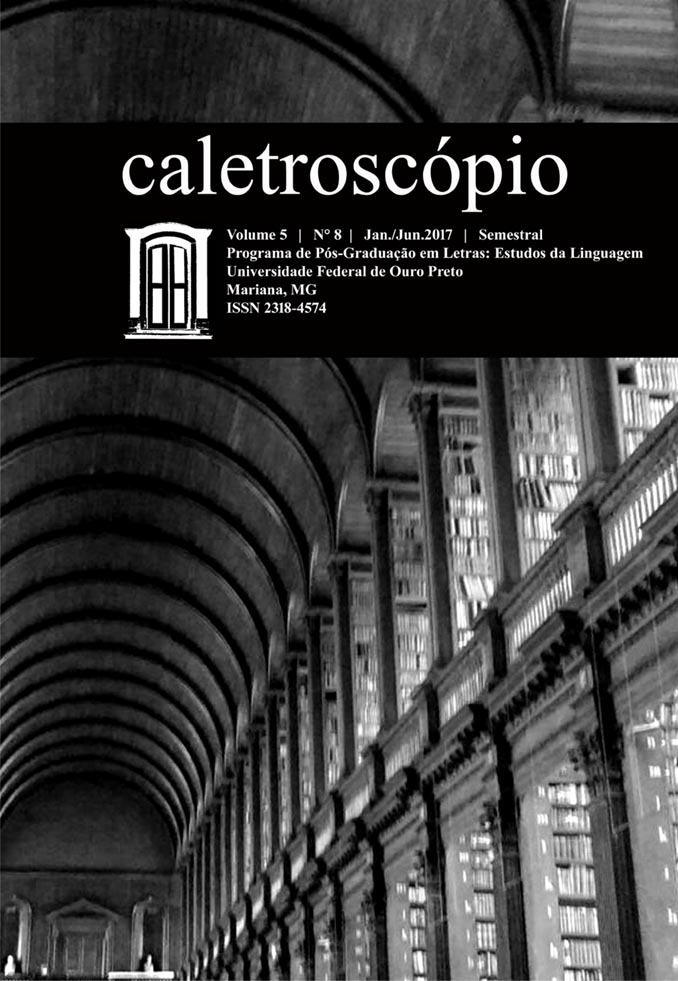Expressões de genericidade: um olhar para as teorias sobre definidos e nominais nus no Português Brasileiro
Resumen
O presente artigo aborda a genericidade nas línguas naturais, com maior enfoque no Português Brasileiro (PB). Seu objetivo principal é realizar um levantamento e discussão das principais teorias propostas para o caso da genericidade no sintagma nominal no PB, como foco no definido genérico e no singular nu (SNu). Dessa forma, baseando-se principalmente em Lyons (1999), abordamos de forma abrangente a discussão teórica sobre genericidade. Em seguida, discutimos as duas posições antagônicas para o caso da genericidade no PB: a de que o SNu no PB é um indefinido e, portanto, um NP (Müller (2002)); e a de que o SNu denota a espécie, ocupando a posição de DP (Schmitt e Munn (2002), Dobrovie-Sorin e Pires de Oliveira (2008)). Porfim, após discutirmos a proposta de Lyons (1999) e sua relação com as teorias propostas para o PB, realizamos uma breve análise sobre a distinção entre o definido e o SNu em relação à genericidade. Concluímos e concordamos com Müller (2002) de que há uma diferença entre o definido genérico e o SNu, mas por razões diferentes. Não porque apenas o primeiro denota um característica inerente e o segundo não é verdadeiramente um genérico (como afirma a autora), mas porque o SNu é um “property-generic”, denotando a intensão do nome.
Descargas
La descarga de datos todavía no está disponible.
Citas
BURTON-ROBERTS, Noel 1976. On the generic indefinite article. Language 52: 427–
48. 1984. Topic and the presuppositions of simple sentences. Paper presented
at the Autumn Meeting of the Linguistics Association of Great Britain,
Colchester.
CARLSON, G. Reference to kinds in English. PhD dissertation, University of
Massachusetts at Amherst, distributed by GSLA. (1977).
DIESING, M. Indefinites. Cambridge: MIT Press, 1992.
CHIERCHIA, G. (1998a). Plurality of mass nouns and the notion of ‘semantic
parameter’. In S. Rothstein (ed.), Events and grammar (pp. 53-103). Dordrecht:
Kluwer ______. Reference to kinds across languages. Natural Language
Semantics n. 6, p. 339- 405, 1998.
DOBROVIE-SORIN, C, OLIVEIRA, R. P. 2007A. Reference to kinds in Brazilian
Portuguese: the definite singular vs. bare singu-lars. In: GRØNN, Atle (Ed.).
Proceedings of SuB12, Oslo: ILOS 2008.
HEIM, I.1982. The Semantics of Definite and Indefinite Noun Phrases. Tese de
Doutorado. Amherst: University of Massachussets.
LONGOBARDI, Giuseppe 1994. Reference and proper names: a theory of NMovement in syntax and logical form. Linguistic Inquiry 25: 609–65.
LYONS, C. Definiteness. Cambridge University Press. 1999.
MÜLLER, A. L. Genericity and the denotation of common nouns in Brazilian
Portuguese. D.E.L.T.A.n.18, p.287-308, 2002.
MUNN, A.; SCHMITT, C. Number and indefinites. Lingua. 115, p.821-855,
2005.OLIVEIRA, Roberta Pires. Semântica formal: uma breve introdução.
Campinas: Mercado das Letras, 2000.
PIRES DE OLIVEIRA, R.; ROTHSTEIN, S. Bare Singular noun phrases are mass in
Brazilian Portuguese. Lingua, 121, 2153-2175. 2011.
SCHMITT, C., MUNN, A., 1999. Against the nominal mapping parameter: bare nouns
in Brazilian Portuguese. In: Proceedings of NELS 29. pp. 339–353.
SCHMITT, C.; MUNN, A. 2002. The syntax and semantics of bare arguments in
Brazilian Portuguese. Linguistic Variation Yearbook 2: 253-269
48. 1984. Topic and the presuppositions of simple sentences. Paper presented
at the Autumn Meeting of the Linguistics Association of Great Britain,
Colchester.
CARLSON, G. Reference to kinds in English. PhD dissertation, University of
Massachusetts at Amherst, distributed by GSLA. (1977).
DIESING, M. Indefinites. Cambridge: MIT Press, 1992.
CHIERCHIA, G. (1998a). Plurality of mass nouns and the notion of ‘semantic
parameter’. In S. Rothstein (ed.), Events and grammar (pp. 53-103). Dordrecht:
Kluwer ______. Reference to kinds across languages. Natural Language
Semantics n. 6, p. 339- 405, 1998.
DOBROVIE-SORIN, C, OLIVEIRA, R. P. 2007A. Reference to kinds in Brazilian
Portuguese: the definite singular vs. bare singu-lars. In: GRØNN, Atle (Ed.).
Proceedings of SuB12, Oslo: ILOS 2008.
HEIM, I.1982. The Semantics of Definite and Indefinite Noun Phrases. Tese de
Doutorado. Amherst: University of Massachussets.
LONGOBARDI, Giuseppe 1994. Reference and proper names: a theory of NMovement in syntax and logical form. Linguistic Inquiry 25: 609–65.
LYONS, C. Definiteness. Cambridge University Press. 1999.
MÜLLER, A. L. Genericity and the denotation of common nouns in Brazilian
Portuguese. D.E.L.T.A.n.18, p.287-308, 2002.
MUNN, A.; SCHMITT, C. Number and indefinites. Lingua. 115, p.821-855,
2005.OLIVEIRA, Roberta Pires. Semântica formal: uma breve introdução.
Campinas: Mercado das Letras, 2000.
PIRES DE OLIVEIRA, R.; ROTHSTEIN, S. Bare Singular noun phrases are mass in
Brazilian Portuguese. Lingua, 121, 2153-2175. 2011.
SCHMITT, C., MUNN, A., 1999. Against the nominal mapping parameter: bare nouns
in Brazilian Portuguese. In: Proceedings of NELS 29. pp. 339–353.
SCHMITT, C.; MUNN, A. 2002. The syntax and semantics of bare arguments in
Brazilian Portuguese. Linguistic Variation Yearbook 2: 253-269
Publicado
2017-08-30
Sección
Artigos - Fluxo contínuo
La Revista Caletroscópio detendrá, por un periodo de tres años, los derechos autorales de todos los trabajos aceptados para publicación: artículos, reseñas, traducciones, etc. Salvo esa restricción, los trabajos están licenciados con la Licencia Creative Commons – Reconocimiento – NoComercial – SinObraDerivada 4.0 Internacional. Después de ese tiempo, caso el autor publique el texto, aunque sean hechos cambios en el original, se solicita que sea incluida, en nota a pie, la información de que una versión anterior del artículo fue publicada en la Revista Caletroscópio, presentando las referencias adecuadas.


